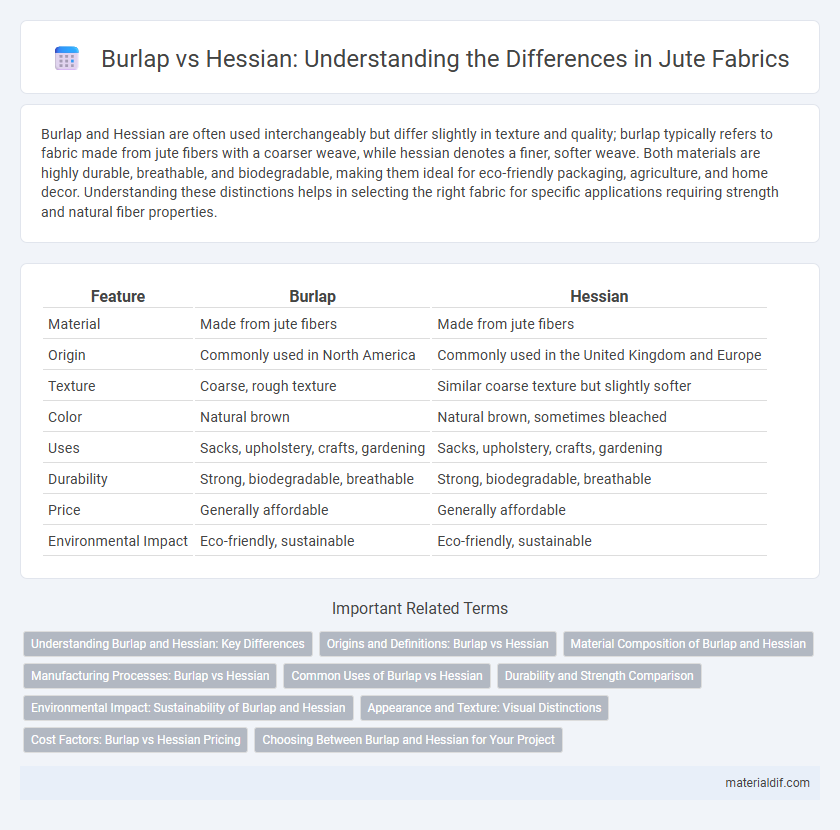Burlap and Hessian are often used interchangeably but differ slightly in texture and quality; burlap typically refers to fabric made from jute fibers with a coarser weave, while hessian denotes a finer, softer weave. Both materials are highly durable, breathable, and biodegradable, making them ideal for eco-friendly packaging, agriculture, and home decor. Understanding these distinctions helps in selecting the right fabric for specific applications requiring strength and natural fiber properties.
Table of Comparison
| Feature | Burlap | Hessian |
|---|---|---|
| Material | Made from jute fibers | Made from jute fibers |
| Origin | Commonly used in North America | Commonly used in the United Kingdom and Europe |
| Texture | Coarse, rough texture | Similar coarse texture but slightly softer |
| Color | Natural brown | Natural brown, sometimes bleached |
| Uses | Sacks, upholstery, crafts, gardening | Sacks, upholstery, crafts, gardening |
| Durability | Strong, biodegradable, breathable | Strong, biodegradable, breathable |
| Price | Generally affordable | Generally affordable |
| Environmental Impact | Eco-friendly, sustainable | Eco-friendly, sustainable |
Understanding Burlap and Hessian: Key Differences
Burlap and Hessian are both coarse woven fabrics made primarily from jute fibers, but Burlap often refers to a rougher, more loosely woven material typically used for sacks and gardening. Hessian features a tighter weave and smoother texture, making it more suitable for upholstery, crafts, and decorative purposes. Understanding these differences helps optimize use based on durability, texture, and aesthetic needs within industries relying on sustainable, natural fiber textiles.
Origins and Definitions: Burlap vs Hessian
Burlap and Hessian both refer to coarse woven fabrics primarily made from jute fibers, with their names differing regionally--Burlap is commonly used in North America, while Hessian is predominant in the United Kingdom and Australia. Originating from the jute plant native to the Indian subcontinent, these textiles share similar production processes but have distinct historical and linguistic roots tied to their regional uses. The terms often describe the same material type, emphasizing durability and breathability, crucial for agricultural and industrial applications.
Material Composition of Burlap and Hessian
Burlap and Hessian are both coarse fabrics primarily made from jute fibers, known for their durability and eco-friendliness. Burlap typically consists of 100% natural jute fibers, offering a rough texture ideal for sacks, gardening, and upholstery, while Hessian may blend jute with other natural fibers like flax or hemp to enhance strength and flexibility. The material composition of Hessian often results in a slightly finer weave compared to burlap, making it preferred for decorative and industrial applications.
Manufacturing Processes: Burlap vs Hessian
Burlap and Hessian both originate from jute fibers but differ in manufacturing processes, where burlap is typically produced using a plain weave technique for a coarser texture, while Hessian involves tighter weaving for enhanced strength and durability. During manufacturing, burlap undergoes minimal processing to retain its rougher, more fibrous nature, whereas Hessian often receives additional treatments like bleaching or dyeing to improve appearance and resistance. These distinctions in weave tightness and post-weaving treatments determine the suitability of burlap and Hessian for various industrial and agricultural applications.
Common Uses of Burlap vs Hessian
Burlap and Hessian, both made from jute fibers, serve distinct purposes despite their similar texture and durability. Burlap is often utilized in gardening and agriculture for soil erosion control, plant protection, and sack production, while Hessian finds frequent use in upholstery, crafts, and decorative applications due to its finer weave and smoother finish. The choice between burlap and hessian largely depends on the required strength and aesthetic appeal for specific industrial or artistic uses.
Durability and Strength Comparison
Burlap and Hessian, both crafted from natural jute fibers, differ significantly in durability and strength, with Hessian typically exhibiting a tighter weave and greater tensile strength that makes it more resistant to tearing under heavy loads. Burlap's looser weave results in slightly less durability, making it better suited for lighter packaging or decorative applications where flexibility is prioritized. The superior durability and strength of Hessian enhance its performance in industrial use, especially in sandbags and agricultural coverings that require reinforced material endurance.
Environmental Impact: Sustainability of Burlap and Hessian
Burlap and Hessian, both derived from jute fibers, offer sustainable options due to their biodegradability and minimal chemical processing. Burlap typically involves coarser jute strands, which require less energy and water, reducing their environmental footprint compared to some Hessian variants. The cultivation of jute plants supports soil health and carbon sequestration, making both materials eco-friendly choices for packaging and textiles.
Appearance and Texture: Visual Distinctions
Burlap typically has a coarser weave with larger, more irregular fibers, resulting in a rougher texture and a rustic appearance. Hessian features a finer, tighter weave that creates a smoother surface and a more uniform color. These visual distinctions make burlap appear chunkier and more rugged, while hessian offers a cleaner, softer look suitable for decorative purposes.
Cost Factors: Burlap vs Hessian Pricing
Burlap and Hessian are both made from jute fibers, but price differences often arise due to weave density and finishing processes. Burlap generally costs less because of its coarser weave and lower processing requirements, making it suitable for budget-conscious applications. Hessian, with a finer weave and smoother texture, demands higher production costs, reflected in its slightly elevated market price.
Choosing Between Burlap and Hessian for Your Project
Burlap and Hessian, both made from jute fibers, differ primarily in weave density and texture, influencing durability and appearance for various applications. Burlap features a coarse weave ideal for rustic decor and gardening projects requiring breathability and moisture control, while Hessian offers a smoother, tighter weave suitable for upholstery and detailed crafts needing a refined finish. Selecting the right material depends on project-specific needs for strength, texture, and aesthetic appeal, ensuring optimal performance and visual impact.
Burlap vs Hessian Infographic

 materialdif.com
materialdif.com